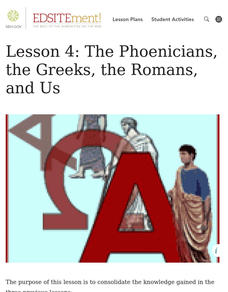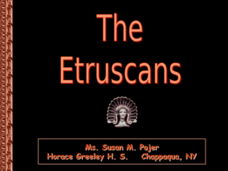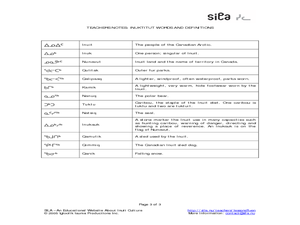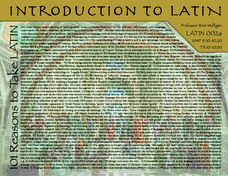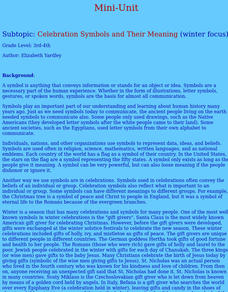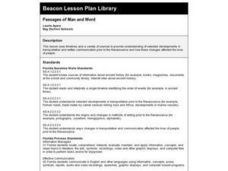Curated OER
The Alphabet is Historic: The Roman Alphabet is our Alphabet
Learners show that the Greeks, Phoenicians and Romans lived in the Mediterranean area. They give reasons why the alphabet was important for the Romans. and say that the Romans developed the alphabet they are learning in school.
Owl Teacher
Teach Ancient Rome!
Teaching the class about Ancient Rome can be fun for you and for them! Check out this incredible resource that has everything you need to bring ancient Roman civilization back to life. Begin by scrolling to the bottom of the page and...
Curated OER
An Alphabet of Roman Goddesses
How much do your young historians know about Roman mythology? Twenty descriptions of Roman goddesses are available with four names to choose from for each question. Use this identification quiz after studying Roman mythology in your...
National Endowment for the Humanities
Lesson 4: The Phoenicians, the Greeks, the Romans, and Us
Learners review knowledge gained in the three-part unit on the history of the alphabet. Using maps and images, learners consolidate their understanding of ancient Greece, the Romans and the Phoenicians, and their respective impacts on...
Curated OER
Familia Romana
Students compare and contrast ancient family life to present day family life. In this Roman family life lesson plan, students discuss the roles present in their families and then learn about family life in ancient Rome. Students...
Curated OER
The Alphabet is Historic
Young scholars describe how the Phoenicians, Greeks and Romans passed down the alphabet through the generations. They compare and contrast the letters from early alphabets to the one of today and discuss how they are different. Using a...
Curated OER
The Etruscans
The Etruscans were a mighty civilization that living in what is now known as Tuscany. Discover their politics, military, writing system, and rulers of Rome through a visual presentation. The work is already done, all you need to do is...
Curated OER
Alternative Alphabet
Students determine and compare hieroglyph content and frequency to sentences constructed in an alternative alphabet based on symbols that mimic sounds of the alphabet. They decide which images are hieroglyphs and which ones are not.
Curated OER
Reading: Alphabet Uno Card Game
Students use the game of Uno to help them learn their numbers and colors. The cards have letters on them instead of numbers.
Curated OER
Alphabet Activities
In this literacy activity, students complete a variety of activities involving the alphabet. They also practice putting words into alphabetical order.
Curated OER
What Comes Before
In this alphabetical order worksheet, students complete 10 questions in which they tell the letter that comes before a specified letter in the alphabet.
Curated OER
Friday the 13th
In this algebra activity, students rewrite words into algebra and algebra in to words. They write out Roman Numeral and scientific notations. There are 13 questions with an answer key.
Curated OER
The Glory That Was Greece: A Test
Did your class just finish a unit on Greek life, culture, and conquest? If you think they know everything there is to know about Ancient Greece, then put them to the test with this exam, which contains thirty multiple choice questions.
Curated OER
Scratch, Glue, Foil & Paint
Students sculpt large Greek and Roman letter design motifs, and replicate other examples of Greek and Roman artwork.
Curated OER
Religion in Japan Japanese Writing
Study the three writing systems of Japanese: Hiragana, Katakana and Kanji. Your middle schoolers will practice writing Kanji and write a mini story in English which uses at least 10 of the Kanji in the place of the English words....
Curated OER
Chapter 12 Writing: the ABCs of Language
Providing a thorough presentation on the art of written language (and not just English), this slideshow will open your students' eyes to the sociological and linguistic issues surrounding writing systems, both modern and historical. The...
Curated OER
The History of Writing
The history of written communication can be an interesting addition to history lessons.
Curated OER
Inuktitut
Students explore Inuit language. In this Inuktitut lesson, students listen to a lecture about the history and phonology of the Inuit language. Students create Inuktitut-English dictionaries with illustrations for younger student use.
Curated OER
China Rocks! Chinese Calligraphy on Stone
Pupils explore the art of calligraphy through writing Chinese characters. They view a Power Point as an introduction to Chinese calligraphy and practice writing Chinese characters. In groups, they visit centers to explore the history of...
Curated OER
The Cultural Geography of East Asia
Students use information from the Asia Society's AskAsia Web site to explore the cultures of China, Japan, and Korea. They answer four questions and then use what they have learned to write a letter of introduction to a Japanese exchange...
Curated OER
Introduction To Latin
In this language arts worksheet, students examine the 101 reasons for taking a class in Latin. The syllabus has classical art for background on the cover page.
Curated OER
Celebration Symbols and Their Meaning
Students develop a symbol that represents something they wish to celebrate or include in a celebration of their choosing.
Curated OER
Population and Population Density
Students read and interpret graphs. In this population instructional activity, students explore population and population density as they read several data graphs and respond to questions.
Curated OER
Passages of Man and Word
Third graders explore transportation and written communication prior to the Renaissance.





